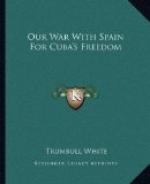Deserted fields and farms.
“All along the railroad, as far as could be seen, were stretches of the most fertile and beautiful country, with very few trees, even on the low mountains, and most of these royal palms. I saw many dozens of burned canefields, and one evening, going from Guines to Havana, saw the sky all lighted up along the road with fires, principally of the tall grass of the country, but partly of cane. The whole land was lying perfectly idle, except that I saw two or three or four sugar mills where cane was growing, but in all such instances the mill and cane were surrounded by forts, manned by soldiers, who are paid, I was told, by the owners. Except in the cities, I saw no indication that any relief whatever was being afforded to the starving people. Neither in Havana nor elsewhere did any priest, religious woman or other person seem to be paying any attention to the wants of the starving, except that at the Fossos, and some other places, charitable Cubans were nursing the sick. The Church, being a state institution, was, so far as I could see, leaving the victims without either bodily or spiritual relief. In fact, the general air of indifference to suffering which seemed to prevail everywhere was astonishing.
A fearful mortality.
“As the country was stripped of its population by the order of concentration, it is easy to believe that 400,000 persons were gathered behind the forts without being given food, medicine, or means of any kind to earn a living, except where in the larger cities some few could find employment in menial offices. Judging by the orphans I was shown at Jacoba, Aidecoa and elsewhere, and from all I saw and heard, I believe that half of the 400,000 have died as the result of starvation. I know from the official register of the city of Santa Clara, which ordinarily has a population of about 14,000, that the deaths for November were over 1,000, and the number of deaths for December was over 900, and showed an increase, considering the loss of the former 1,000, from its total population. The exact figures for December are 971. At that city the government was distributing 500 single rations per day out of a total appropriation for the purpose of $15,000. This was not relief, but a mere prolongation of the sufferings of a small part of the reconcentrados of the city.




